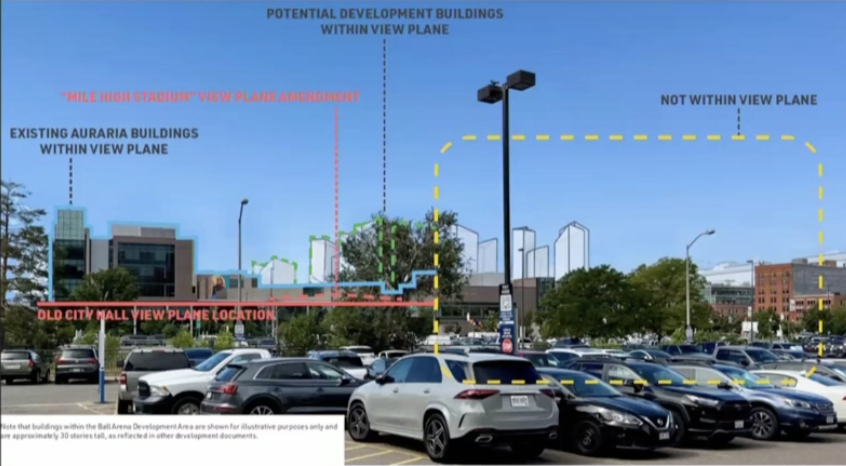
Evan Semón

Audio By Carbonatix
Denver City Council just gave the Kroenke family the go-ahead to move forward with a massive redevelopment project around Ball Arena.
The votes came late on Monday, October 21, after a marathon council meeting that included four public hearings regarding various elements of the Kroenke Sports & Entertainment plan to turn the 55 acres of parking lots around Ball Arena into a brand-new neighborhood next to downtown. KSE is the company through which the Kroenke family – which owns the Denver Nuggets, Colorado Avalanche and Colorado Mammoth – conducts most of its business in Colorado.
What could turn into a residential/retail neighborhood over the next twenty years is today primarily a series of surface parking lots for Ball Arena. The Kroenke development proposal calls for new roadsinto this area, including a “Sports Mile” connecting Ball Arena to Coors Field. The project would add thousands of square feet of residential and retail space, along with a new public park that would be a central feature.
For the last several months, councilmembers who are part of the newly constituted South Platte River Committee have heard from city staffers and KSE employees about proposed rezoning that would allow denser development, as well as a plan to guide the development process, new taxing districts to fund parts of the development, and an additional rezoning move that would exempt the development from Denver’s view-plane rules.
Denver, make your New Year’s Resolution Count!
We’re $15,500 away from our End-of-Year campaign goal, with just a few days left! We’re ready to deliver — but we need the resources to do it right. If Westword matters to you, please contribute today to help us expand our current events coverage when it’s needed most.
On October 21, council delivered final decisions on all of those critical issues.
City Council Exempts Development from View Plane Rule
How the Ball Arena would impact the Old City Hall view plane from the origin point of the view plane. Denver Department of Community Planning and Development
KSE had applied for an exemption to the Old City Hall view plane, which is designed to ensure an uninterrupted sightline from central Denver to the Rocky Mountains; it’s one of fourteen view planes in the city, and would have limited heights for buildings on most of the property from between 70 to 95 feet. 
But the Auraria Campus, which is right next to Ball Arena, is already exempt from the view plane because it is a state enterprise – and that led Denver Community Planning and Development to question the usefulness of the view plane today. Ultimately, council agreed, deciding 10-1 to allow the exemptions in its first vote of the day.
Some of those whose views would be impacted were unhappy with the decision; one resident argued that council should consider not just the technical definition of the view plane, but views around the city that might be altered – such as the view of the mountains from the Colorado Convention Center.
The lone “no” vote came from Amanda Sawyer, who represents council district 5 and suggested that if the view plane is truly no longer relevant, it should be repealed completely.
“To set the precedent where we are piercing a view plane out of convenience because somebody really, really wants it to do – what we’ll see later tonight may or may not be a really good development – is not a precedent that I am willing to set,” Sawyer said.
Ball Arena Property Rezoned Unanimously
To create the neighborhood it envisions, KSE needed the property to be rezoned. The Ball Arena area was previously zoned for a maximum building height of five or eight stories, depending on the exact location of the proposed structure. While that zoning category allowed for commercial and residential uses, it’s meant to be less dense than a typical downtown district.
The rezoning created a transition area from the edge of the Auraria Campus along Speer Boulevard, which will maintain lower building heights, to the rest of the property, which now falls into a zoning type designed for the Central Platte Valley and Urban Center and approved in 2018.
This zone type does not put a maximum height on towers. Rather, towers are governed by a floor-area ratio that requires buildings to get skinnier as they get taller. Unlike under Denver’s current zoning, this type requires tall buildings to be spaced out by at least eighty feet, rather than being stacked right next to other towers. Most building types allowed under this zoning also require upper-story setbacks to promote views when looking up from the street.
During the public hearing on this Kroenke ask, critics shared parking and transportation concerns. But for the most part, people spoke in support of the rezoning, praising the higher density that would come with the change.
All eleven city councilmembers voted yes on the rezoning, with most citing a Community Benefits Agreement reached between KSE and a committee comprising members of the Auraria community, Denver Housing Authority, Denver Streets Partnership and the La Alama Lincoln Park, Sun Valley and downtown Denver neighborhoods. The CBA, signed on October 16, includes a $16 million fund for community-centered projects.
“This rezoning is possible for me because of two things,” said Jamie Torres, whose district includes the development area. “Obviously, the criteria. …and because of the community benefits agreement.”
Nuggets, Avalanche to Stay Downtown Until 2050
The next item that council considered: the development agreement between the City of Denver and KSE. This document governs many aspects of the project, including requirements for affordable housing, parks and open space and economic benefits. Much of the development agreement matches language in the Community Benefits Agreement.
Under this agreement, 18 percent of the units will be affordable, with some integrated into mixed-income buildings and others in all-affordable buildings. Affordable housing will be included during every phase of construction and spread across the geographical area of the development.
KSE will be required to set aside at least 12 percent of the land in the development as open space; that includes a 3.5-acre park that will be turned over to Denver Parks & Recreation once completed. The River Mile, an adjacent but different KSE-connected development, had already agreed to build the shell of a new rec center for Denver Parks & Rec; the Ball Arena project will fully outfit that facility so that the area will have a complete public rec center when both projects are done.
Economic benefits in the development agreement start with a KSE commitment to build an on-site child-care facility and prioritizing Denver residents for jobs during construction and in the neighborhood after project completion.
“I just hope it’s as good as you say it is,” said Brandy Majors, who shared her concerns about Denver residents actually getting jobs in the area once it is developed.

The Denver Nuggets will be in downtown Denver until 2050.
Evan Semón Photography
Should KSE convey any land to the city, the company will be required to environmentally remediate the site before it does so.
And finally, the agreement with the city includes vesting rights that will keep every requirement and agreement in place through 2050, with the stipulation that the Avalanche, Nuggets and Mammoth all stay in Denver until that date.
Council unanimously approved the development agreement.
“I still know that this is just the beginning of a long process,” said councilmember Flor Alvidrez. “I didn’t see anything about grocery stores, so food access. There’s still some holes that I see, like the HOA, what are those fees going to be? But I know that you guys are going to be good partners with us, and we can work through that over the long term.”
In a related move, council also unanimously approved an amendment to the River Mile development agreement. Part of this project involves fixing the South Platte River to eliminate floodplain concerns involving much of the land for both developments.
As part of the River Mile deal, Kroenke had agreed to keep the Nuggets and Avalanche in Denver until 2038; this amendment lengthens the time those teams will stay in Denver while also allowing KSE to build another arena on either the Ball Arena or River Mile sites during that time if the company chooses to do so.
KSE Development Will Tax Itself to Fund Infrastructure Updates
Council also okayed the creation of five metropolitan districts to finance the Ball Arena project. One will be a maintenance district for public improvements beyond what the city would typically undertake. The others will be financing districts devoted to raising funds to build the public infrastructure needed to support the population and activity growth in the area. According to Denver Department of Finance estimates, the proposed development will require the support of $635 million in investments.
“Some of these infrastructure improvements include two pedestrian bridges, the parking structures, the signature park and two different open spaces within the district,” Finance’s Laura Wachter had explained at an earlier meeting. “The roads, safety, protection, the drainage,and then other, just, earthworks and street landscaping as well.”
Anyone who owns property in one of the districts will pay the relevant fees and taxes, with lower costs for those who own affordable units or buildings. Unlike other decisions made during the meeting, the one involving financing wasn’t unanimous; councilmembers Sarah Parady, Serena Gonzales-Gutierrez and Sawyer all voted against it. Sawyer was the only one to offer a comment, saying she was not comfortable with the high level of taxing that would be allowed by the metro districts.
“I think that doubling, potentially doubling, the property taxes for the residents who are living in here is extraordinary,” she said. “In a city where we need to focus on affordability, this is not going to be affordable…. I love this development. I love the idea of bringing more density to this area. I love the idea of all of the different things that we talked about tonight. I am not comfortable with this financing mechanism.”
Still, the development can now move forward with other planning elements. There is no timeline for construction; KSE had said it wanted to get through the rezoning first, in order to avoid getting ahead of itself.